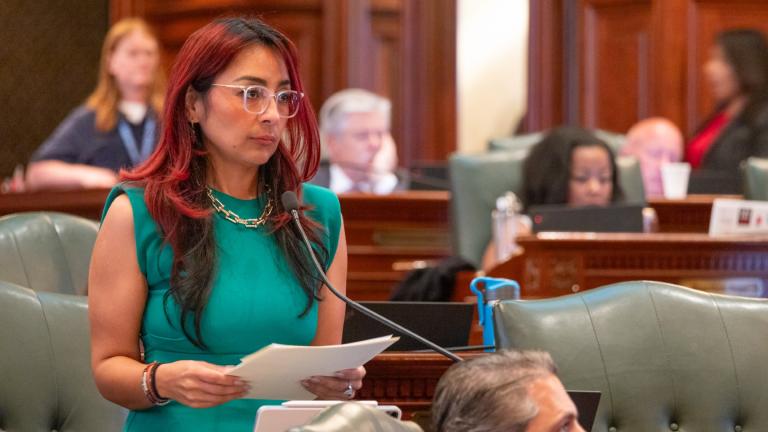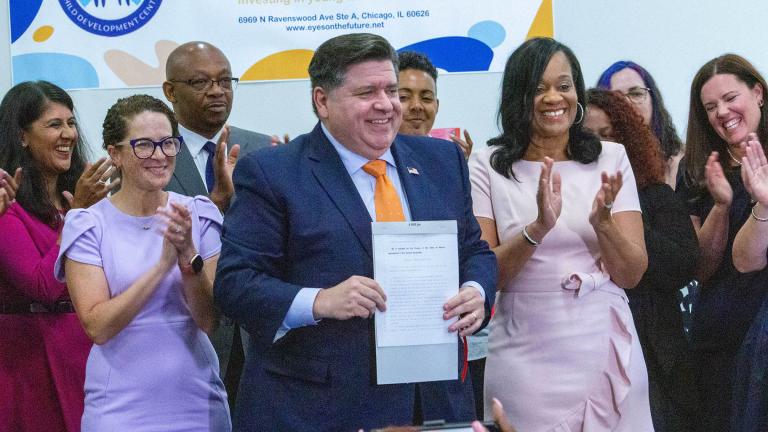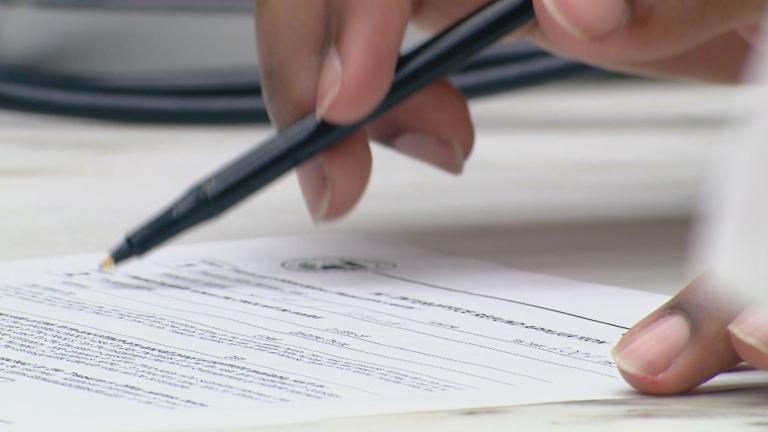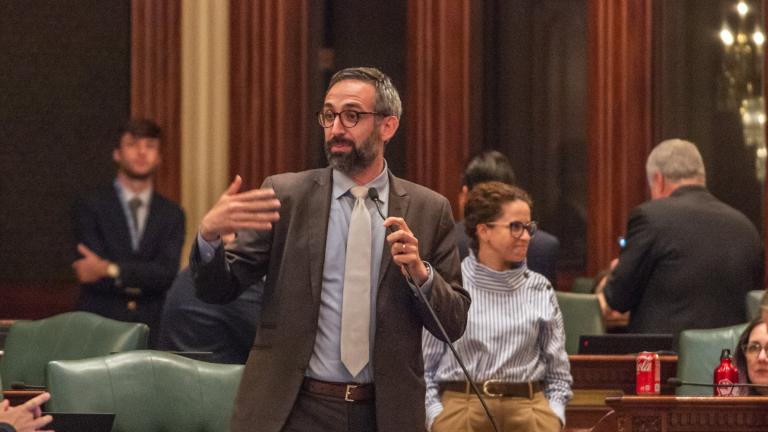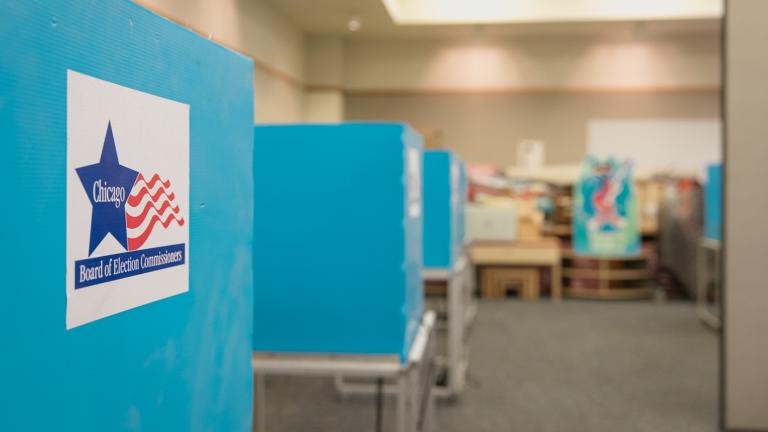With roughly a month before they plan to complete the weighty task of drawing new maps that will determine the lines of political power for the next decade, Illinois Democrats say they have not determined what data they’ll use.
“Whatever that data is we’re going to use, we haven’t made that decision yet,” Sen. Elgie Sims, a Chicago Democrat who serves as the vice-chair of the chamber’s redistricting committee, said Tuesday on “Chicago Tonight” while giving assurances that the drawing of district boundaries will be done in a transparent way.
The Republican spokesperson of the House redistricting committee, Rep. Tim Butler of Springfield, said the Republican Party has asked questions about what Illinois population data will be used during the redistricting process, but has received no answers.
“We have huge concerns about what data is going to be used,” Butler said, and whether it “reflects truly the diversity of Illinois.”
Typically, Illinois and other states would use information from the census.
But due to the pandemic and changes made by President Donald Trump’s administration during a particularly embattled census enumeration process last year, the federal government isn’t set to deliver the census results until August or September --- after the Illinois legislature’s scheduled May 31 adjournment date.
READ: Illinois to Lose Congressional Seat as State’s Population Declines
State Rep. Will Davis, D-Hazel Crest, said the blame lies with Trump.
“We’d be well on our way had the previous administration not done what it had done to delay this process and I think our objective is to try to pass something by May 31,” Davis said.
An August or September arrival of the census data would also come after a June 30 deadline in the state constitution that would hand over map-making power from the Democratic-controlled legislature to a panel of eight lawmakers – four Democrats, and four Republicans — who would then have until Aug. 10 to approve a map on a bipartisan basis.
Video: Lawmakers weigh a ComEd rate hike nearly a year after a bribery scandal broke. Our discussion continues on that topic and more with state Sens. Sue Rezin (R-Morris) and Elgie Sims (D-Chicago); and state Reps. Tim Butler (R-Springfield) and Will Davis (D-East Hazel Crest).
Past that, Illinois’ constitution effectively leaves to chance which party gets the upper hand in drawing districts that could give its candidates an advantage in future political races: The constitution calls for the secretary of state to “draw by random selection” a ninth legislator to serve as the tie-breaking vote on the panel.
The constitution’s drop-date is Oct. 5 for the map-making work to be completed.
Republicans accuse Democrats of rushing the process so they can maintain control and predict Democrats will use data from the American Community Survey (ACS) – a survey performed by the U.S. Census Bureau that’s done on a significantly smaller scale than the once-every-decade census.
“As long as my colleagues across the aisle want to use the ACS as a point for drawing the map, this is not a fair map. ACS data is simply an estimate,” state Sen. Sue Rezin of Morrisonville said. “There should be no rush using this estimated data from the ACS.”
Sims said it’s “misleading” to reduce the gravity of the June 30 deadline “because it’s clearly delineated in the state’s constitution,” he said, adding that if it gets the point that a legislators’ name is effectively drawn out of a hat, the result would be totally partisan.
He repeatedly committed to the General Assembly, in which Democrats hold supermajorities in both chambers, passing a bill containing a new set of maps before June 30.
“If there is a map that the Republicans want to propose we certainly want to see it, but you cannot just say no,” Sims said. “We want you to be partners with us.”
Republicans allege Democrats amassed those supermajorities in part thanks to the 2011 maps Democrats drew slanted in their favor and believe Democrats will again gerrymander districts with the next set.
“The maps are being drawn by the party in control as we speak,” Rezin said.
Trying to undermine Democrats’ plans for designing the 2021-2031 maps is the Republican Party’s best chance for getting to control the process, by triggering the 50/50 name-out-of-a hat, last-chance option.
The high-stakes nature of the political gamesmanship – and potential long-term consequences for races down the road – has led various outside organizations to call for Illinois to remove any responsibility from legislators to draw their own maps, and instead leave that to a commission of “independent” residents.
Gov. J.B. Pritzker, at an unrelated news conference earlier Tuesday, signaled, in response to reporters’ repeated questions, that it’s too late for that option.
“The legislature is working on the map for the next 10 years,” Pritzker said.
As a candidate, Pritkzer responded to a 2018 survey by the political online forum Capitol Fax by saying that he would veto any map “that is in any way drafted or created by legislators, political party leaders and/or their staffs or allies.”
“We should amend the constitution to create an independent commission to draw legislative maps, but in the meantime, I would urge Democrats and Republicans to agree to an independent commission to handle creating a new legislative map,” Pritzker wrote. “That designated body should reflect the gender, racial, and geographic diversity of the state and look to preserve the Voting Rights Act decisions to ensure racial and language minorities are fully represented in the electoral process.”
On Tuesday, Pritzker recommitted to vetoing an “unfair map” while praising the last, 2011 version designed by members of his party.
“As I’ve said, I will veto an unfair map. I’ve also said that in order for us to have an independent commission, we needed to have a constitutional amendment, something that would actually change the way the process operates today in the constitution. That did not happen. So now, as we reach the end of this session, I look to the legislature for their proposal for a redistricting map. I’ll be looking to it for its fairness,” Pritzker said. “The map that was put together for the last 10 years started out with a very strong leaning toward fairness,”
Pritzker also accused Republican legislators of not engaging in the current redistricting process, which has included dozens of legislative hearings in which members of the public have testified about their aspirations for future districts.
For the first time, the state also has a portal that allows individuals and organizations to digitally submit their own ideal maps.
“I hope that Republicans will choose to work with Democrats on the map. Right now, it looks like they’re just saying no, they’re not really engaging and all they’re doing is fighting in these redistricting hearings,” Pritzker said.
Republican Butler rebuffed the accusation, saying that he’s been part of many of the hearings.
Even so, Butler said he has unanswered questions: Whether ACS data will be used, and what the process for citizen involvement will be once the maps are unveiled.
“For the governor to say that we’re not coming to the table is ludicrous,” Butler said.
The state learned Monday that it will lose one seat in Congress, leaving the state with a 17-member delegation to the U.S. House.
Expectations are that Democrats will design the new boundaries in a manner that leaves one of the state’s five Republican members of Congress without a district in which they could viably compete.
Illinois was one of only three states to lose residents in the past decade.
Still, Pritzker signaled that the early census results made public this week aren’t bad, considering the “carnival barkers” and critics who have bemoaned Illinois losing throngs of residents due to their frustration with Illinois’ political and tax climate.
”There are many carnival barkers and people who have run down this state for years who have said, talked about, ‘we’ve lost hundreds of thousands of people over the last 10 years.’ As it turns out it’s about 7,500 people,” he said.
Pritzker said the state’s efforts to provide residents with health care, opportunities “for job creation through new businesses,” and scholarships and grants to attract and retain students are among the reasons residents are moving to and staying in Illinois.
Follow Amanda Vinicky on Twitter: @AmandaVinicky

